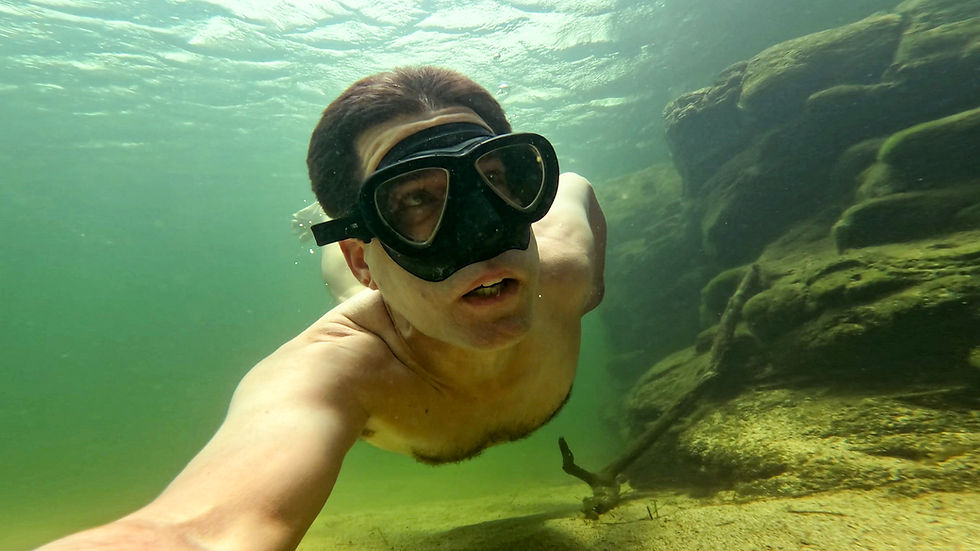Breaking the Loop - worth reading not only for CCR divers
- Michael Mutter

- 19. Aug.
- 3 Min. Lesezeit
In rebreather diving, there is a clear mantra: “If in doubt, bail out.” But how easy is it really to make this decision in a stressful situation?
Jane Ruckert, University Diver at the University of Fremantle with extensive CCR and expedition experience, conducted her own survey among CCR divers. For her article “Breaking the Loop: Here are Your Bailout Stories,” published in InDEPTH Magazine in August 2025, she collected testimonials that show how divers actually react in critical moments – and why.

The dive that almost went wrong
The article begins with a haunting scene: An experienced diver is undergoing decompression. Everything seems fine — the oxygen set point is stable at 1.4, the readings are correct. And yet he has a nagging feeling that something is wrong.
He takes the decisive step, bails out, and he breathes from the open system. Shortly afterwards, the thought occurs to him: maybe it was just a false alarm. He switches back to the loop – only to realise seconds later that the uneasy feeling remains. He immediately goes back to bailout and stays there this time.
A subsequent investigation reveals that a leaky mushroom valve (one-way valve) could have led to disaster in a matter of seconds, as it caused CO2 to be rebreathed.
The lesson: training beats courage
Ruckert's central message is clear: in an emergency, it doesn't matter whether you stay “cool” or love risks. What matters is whether you can call on a trained, automated pattern of action. Technical divers know that equipment failures can occur at any time. But people often underestimate how much psychological factors - doubt, peer pressure, fear of gas loss - can influence decisions.
Two points that particularly caught my eye:
1. A surprising number of bailouts – even among beginners
It comes as no surprise that many experienced CCR divers with more than 1,000 rebreather hours have switched to bailout at some point (approx. 90%) – especially during very demanding dives. However, the percentage of divers with less than 50 hours of experience who have already made a bailout (over 50%) is unexpectedly high.
Even more surprising is the percentage of cases where a flooded unit was the trigger. One would think that modern CCRs offer solid safety in this regard. The survey does not disclose exactly which devices were affected. It is possible that experienced divers have also dived with older, less safe systems during their careers.
However, I wonder whether a bailout was really always necessary for inexperienced divers. Unfortunately, there is no information on this – and this applies to all bailouts, of course, as it is self-reported data. Especially for beginners, uncertainty could lead to a switch to bailout, even if the device was technically sound. This would make the number of bailouts in this group appear “artificially high.” After all, modern CCRs are quite reliable – and inexperienced divers are likely to have dived with newer models.
2. Peer pressure as a risk
The most striking finding: social pressure can be so great that divers downplay a potentially dangerous problem – just to avoid drawing unwanted attention, disrupting the group's dive, or embarrassing themselves if they fail to complete an exercise or task because they have to bail out. This psychological factor is often subtle, but can become a dangerous trap at depth.
This is precisely why the article is so relevant: not so much because of the technical question of bailouts, but because it openly addresses the issue of peer pressure and raises awareness of how much it can influence safety decisions. Because this applies to all divers.
Peer pressure must not take precedence over safety
Why stories make a difference
What makes “Breaking the Loop” special is its focus on real voices from the community. These bailout stories are not dry accident reports, but personal accounts that many divers can relate to. They show that the most dangerous loop is not always made up of hoses and valves – sometimes it's in your own head.
Conclusion: Practice, practice, practice – and communicate
Whether in training or when exchanging experiences in the diving community: scenario training for bailouts should not only include technique, but also decision-making psychology. Those who learn to make decisions immediately during training will not hesitate in an emergency.
And perhaps it is just as important to share these stories as it is to share the technique itself – so that no one finds out the hard way how difficult it can be to get out of the loop.
Particularly important: group pressure must be completely eliminated in an emergency. If a problem arises, it should not matter how the group reacts or whether the dive is “ruined.” Safety comes first – always. This insight applies not only to CCR divers, but to everyone who dives.





Kommentare